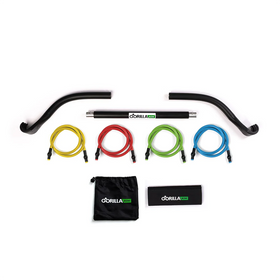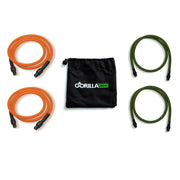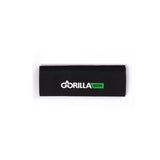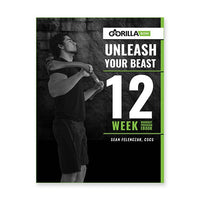What Are Macros All About? How to Use Them for Your Fitness Goals

Macronutrients (macros for short) are the building blocks of the food you eat. Your body needs these nutrients for energy and to function correctly, and anyone interested in health will need to understand how they work.
Below, we’ll cover macronutrients, the different types, how they relate to micronutrients, and how to use them for your fitness goals.
What Are the Three Macronutrients?
Macronutrients are the nutrients your body needs in the most significant quantities. They fall into three main categories:\
- Carbohydrates
- Protein
- Fat
Some popular diets cut out specific macros or focus too much on others. However, many of these eating plans are fad diets. Most people should get a balance of all three macronutrients to maintain a healthy diet.
Let’s look more closely at each.
1. Carbohydrates
Carbohydrates (or carbs) are the body’s favorite energy source. When you eat carbs, your body quickly turns them into glucose for immediate fuel. Starches, sugars, and fibers are the three types of carbohydrates.
Food sources of carbs include:
- Beans and legumes
- Fruits and vegetables
- Grains
- Nuts and seeds
- Milk
- Added processed sugars, such as those in candies and baked goods
Eating large amounts of carbohydrates can increase blood sugar levels. However, carbs are still necessary for fitness — it’s just best to focus on whole versions like fresh (or frozen) fruits and vegetables, whole grains, beans, nuts, seeds, and no-added-sugar dairy.
Minimize added sugars; only consume them in moderation. And note that processed sugars can go by many different names on nutrition labels, including:
- Cane sugar
- Corn syrup
- Honey
- Agave nectar
- Sucrose
- Fructose
- Dextrose
How Many Carbs Do You Need?
Carbohydrates provide four calories per gram. In addition, the Dietary Guidelines for Americans recommend getting 45-65% of your daily calories from carbs.
The range accounts for different health goals and concerns. So, your carb intakes might vary if you’re trying to lose weight, build muscle, or maintain muscle. This Bodybuilding.com calculator can help you calculate how many carbs per day you should consume.
2. Protein
Proteins are nutrients that your body needs for many different processes, including:
- Providing structure to skin, hair, muscles, and other tissues
- Regulating tissues and organs
- Repairing tissue damage
- Maintaining proper acid-base balance
- Carrying out chemical reactions in cells
Protein is also what your body needs to build and protect lean muscles.
Protein is made up of amino acids, and there are two types: essential and non-essential. You can only get essential amino acids from food, but your body makes non-essential amino acids. So, you only need to think about foods that provide essential amino acids.
Food sources of protein include:
- Meat and poultry
- Seafood
- Dairy products
- Beans and legumes
- Soy proteins like tofu and tempeh
- Nuts and seeds
- Whole grains
Be careful with how frequently you consume red and processed meats, as they may increase the risk of disease. Examples include lunch meats, bacon, and hot dogs. According to MD Anderson Cancer Center, it’s best to eat no more than 18 ounces per week of red meat and no more than two processed portions of meat per week.
Government guidelines note that many Americans don’t meet the recommendations for certain types of proteins. For example, nearly 90% don’t consume enough seafood, and over 50% don’t get enough soy products, nuts, and seeds. At the same time, around 75% of Americans meet or go over the suggestions for meat, poultry, and eggs.
Try to incorporate more plant-based proteins into your diet for added fiber, vitamins, minerals, and phytonutrients, and a reduced risk of disease. Just keep in mind that the body absorbs plant proteins differently than animal proteins. Vegans should eat legumes regularly and make sure they get enough calories to meet protein needs.
How Much Protein Do You Need?
Like carbs, protein provides four calories per gram. And the Dietary Guidelines for protein are 10-35% of daily calories for most adults. The daily recommendation is at least 0.8 grams of protein per kilogram of body weight (about 0.36 grams per pound).
If you are weight training, you’ll want to focus on the higher end of the protein guidelines range. Extra protein helps support muscle growth and recovery.
3. Fats
Last but not least, let’s talk about fats.
Fats are necessary for:
- Helping the body absorb and store vitamins A, D, E, and K
- Storing energy in the body
- Insulating and protecting vital organs
- Regulating energy in the body
We also get essential fatty acids — which our bodies cannot make themselves — from dietary fats. The primary essential fatty acids are omega-3s and omega-6s.
Common food sources of fats include:
- Vegetable oils, including canola oil, olive oil, and avocado oil
- Nuts and seeds
- Fatty fish like salmon and tuna
- Olives
- Avocado
How Much Fat Do You Need?
The Dietary Guidelines for protein are 20-35% daily calories from fat. Fewer than 10% of your calories should come from saturated fats.
According to the American Heart Association (AHA), olive, canola, safflower, soybean, sunflower, peanut, and corn oils are the healthiest vegetable oils. Blends of these oils are also okay. Avocado, grapeseed, and sesame oil are also healthy choices — they’re just pricier. And make sure you are getting essential fatty acids from foods like fatty fish, chia seeds, flaxseeds, hemp seeds, and canola oil.
Limit or avoid fats from fried foods, palm kernel oil, butter, cream cheese, and full-fat dairy as often as you can. A good rule of thumb is to reduce the consumption of tropical oils and solid fats.
What to Know About Macronutrients vs. Micronutrients
Macronutrients and micronutrients have fundamental differences, and they are easy to confuse.
Basically, macronutrients are the nutrients your body requires in large amounts, and that make up your diet. Micronutrients are needed in smaller quantities, and they include vitamins, minerals, and water.
You need both macronutrients and micronutrients to thrive and stay healthy. When you focus on the healthy versions of carbs, proteins, and fats we’ve listed above, you will naturally meet your needs for many micronutrients.
Should You Count Macros?
Many in the fitness world count macros to monitor their diet and track progress. If you’ve ever heard of If It Fits Your Macros (IIFYM), you’ll be familiar with this concept.
Counting macros is a type of flexible dieting where you focus on macronutrients instead of calories to lose weight or achieve other health goals. For most people, that means eating whatever you want as long as it fits into your macro percentages.
For example, someone’s macro goals might be 50% carbs, 30% protein, and 20% fats. They would use these percentages to calculate how many grams of carbs, protein, and fats they can eat each day.
Athletes and those trying to lean down or build muscle will often focus on macros to ensure they’re getting enough protein.
Some people love counting macros, but it’s also not for everyone. If you have specific fitness goals, counting macronutrients can help you track your nutrient ratios without obsessing about calories or clean eating. That being said, many people can often meet the intakes they desire through a well-balanced diet.
MD Anderson recommends visualizing your macro ratios on a plate:
- Whole grains, vegetables, fruits, nuts, and seeds should fill two-thirds of the plate.
- Lean protein and plant-based proteins should fill one-third of the plate.
You might need to find what works best for you. The important thing is finding healthy eating patterns you can maintain to help you meet your health-related goals.
How to Use Macronutrients for Your Fitness Goals
If you’d like to give tracking macros a try, that’s great! We’ll help you get started. But first, as a reminder, the recommended ranges for macro percentages are:
- Carbs: 45-65% of your daily calories
- Protein: 10-35% of your daily calories
- Fats: 20-35% of your daily calories
Calculating Your Macronutrient Breakdown
First, find out your basal metabolic rate (BMR) — the number of calories your body needs just to function.
The formula is:
- For men: your body weight in kilograms x 24
- For women: your body weight in kilograms x 22
The number you get should be your BMR.
(If you need to convert from pounds to kilograms, simply multiply your weight in pounds by 0.454.)
You’ll also need to account for your energy levels. Here are the formulas. You’ll multiply your BMR by the numbers given based on how active you are:
- Sedentary: BMR x 1.1
- Lightly active: BMR x 1.3
- Moderately active: BMR x 1.5
- Very active: BMR x 1.7
Now, we’ll use your BMR to make adjustments that help you calculate your macros for different health goals.
Using Macronutrients to Lose Weight
You’ll need to take in fewer calories than you burn to lose weight. Focus on the healthy versions of each macronutrient to reduce the chance of over-eating from processed and calorie-dense foods.
You’ll also need to give yourself a calorie deficit. According to WebMD, a reasonable calorie deficit for weight loss is 500 fewer calories per day.
So, subtract the deficit from your BMR. If your activity level goes up, you’ll need to account for that so that you don’t end up eating too few calories.
Here are the macro percentages that registered dietitian Amy Goodson recommends based on activity level, according to Prevention:
- For those who exercise an hour or less daily: 40% carbs, 30% protein, 30% fat
- For those who exercise 1-2 hours daily: 45% carbs, 30% protein, 25% fat
- For those who exercise over two hours per day: She recommends seeing a dietitian for personalized recommendations
You might also use an app to calculate your calorie and macro needs. Apps can help you track your meals and monitor your macro percentages during the day.
Using Macronutrients to Build Muscle
If your goal is muscle gain, you’ll need to be in a slight calorie surplus so that your body has the energy necessary to build muscle tissue. Generally, you’ll need to take the BMR plus activity calculation above and add 250 to 500 calories per day.
Next, it’s best to start by calculating your ideal protein percentage. According to the American College of Sports Medicine (ACSM), 0.5 to 0.8 grams of protein per pound of body weight is suitable for those training to build muscle mass. Use these numbers to calculate your protein percentage; then, you’ll be able to obtain your carbs and fat numbers.
The macro ratios recommended by Bodybuilding.com are:
- For bodybuilding: 40-60% carbs, 25-35% protein, 15-25% fat
- For muscle maintenance: 30-50% carbs, 25-35% protein, 25-35% fat
- For fat loss: 10-30% carbs, 40-50% protein, 30-40% fat
You might have to play around with the numbers within each range to find what works best for you. Remember that a healthy diet is one that you can stick with long-term.
Also, while building muscle, pay special attention to the quality of the foods you’re eating. We’re talking more of the healthy macro sources mentioned in this article and less junky and processed foods. Poor-quality nutrition choices will not help you with muscle gain — in fact, it can hinder it a great deal.
If your head is spinning from all of this information, you might consider working with a registered dietitian who can help you find the plan that’s best for you.
Online fitness communities can also help you stay on track with your workouts and diet plans. With Gorilla Bow All-Access, you can access premium nutrition tips, advice from certified trainers, and a 24/7 on-demand library with video workouts in any style you could think of.
Wrapping Up: What Are Macronutrients?
In conclusion, macronutrients are three major nutrients your body needs to function and stay healthy. It’s essential to understand the roles of carbs, proteins, and fats, and you can use a balance of each to meet your fitness and health goals.
If you’re interested in counting macros for your fitness goals, we’re all for it. Just give yourself time to adjust, especially if you are new to nutrition tracking and fitness in general. Remember, it’s all about progress, not perfection, and finding the balance that allows you to achieve your goals — and maintain progress.
And if you want an all-in-one workout system that you can use anywhere, check out our Gorilla Bows. You’ll discover the magic of resistance training on your health, fitness, and physique. Combine our programs with your target macros to start seeing real results.
Sources:










Leave a comment